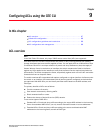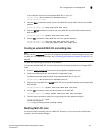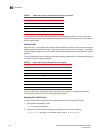
Dell Converged Enhanced Ethernet Administrator’s Guide 93
53-1002116-01
Chapter
10
Configuring QoS using the CEE CLI
In this chapter
•QoS overview . . . . . . . . . . . . . . . . . . . . . . . . . . . . . . . . . . . . . . . . . . . . . . . . . . 93
•Rewriting . . . . . . . . . . . . . . . . . . . . . . . . . . . . . . . . . . . . . . . . . . . . . . . . . . . . . 94
•Queueing . . . . . . . . . . . . . . . . . . . . . . . . . . . . . . . . . . . . . . . . . . . . . . . . . . . . . 94
•Congestion control. . . . . . . . . . . . . . . . . . . . . . . . . . . . . . . . . . . . . . . . . . . . . 100
•Multicast rate limiting . . . . . . . . . . . . . . . . . . . . . . . . . . . . . . . . . . . . . . . . . . 103
•Scheduling . . . . . . . . . . . . . . . . . . . . . . . . . . . . . . . . . . . . . . . . . . . . . . . . . . . 104
•Converged Enhanced Ethernet map configuration . . . . . . . . . . . . . . . . . . . 107
QoS overview
Quality of Service (QoS) provides you with the capability to control how the traffic is moved from
switch to switch. In a network that has different types of traffic with different needs (CoS), the goal
of QoS is to provide each traffic type with a virtual pipe. FCoE uses traffic class mapping,
scheduling, and flow control to provide quality of service.
Traffic running through the switches can be classified as either multicast traffic or unicast traffic.
Multicast traffic has a single source but multiple destinations. Unicast traffic has a single source
with a single destination. With all this traffic going through inbound and outbound ports, QoS can
be set based on egress port and priority level of the CoS.
QoS can also be set on interfaces where the end-station knows how to mark traffic with QoS and it
lies with the same trusted interfaces. An untrusted interface is when the end-station is untrusted
and is at the administrative boundaries.
The QoS features are:
• Rewriting—Rewriting or marking a frame allows for overriding header fields such as the priority
and VLAN ID.
• Queueing—Queueing provides temporary storage for frames while waiting for transmission.
Queues are selected based on ingress ports, egress ports, and configured user priority level.
• Congestion control—When queues begin filling up and all buffering is exhausted, frames are
dropped. This has a detrimental effect on application throughput. Congestion control
techniques are used to reduce the risk of queue overruns without adversely affecting network
throughput. Congestion control features include IEEE 802.3x Ethernet Pause, Tail Drop, and
Ethernet Priority Flow Control (PFC).
• Multicast rate limiting—Many multicast applications cannot be adapted for congestion control
techniques and the replication of frames by switching devices can exacerbate this problem.
Multicast rate limiting controls frame replication to minimize the impact of multicast traffic.


















